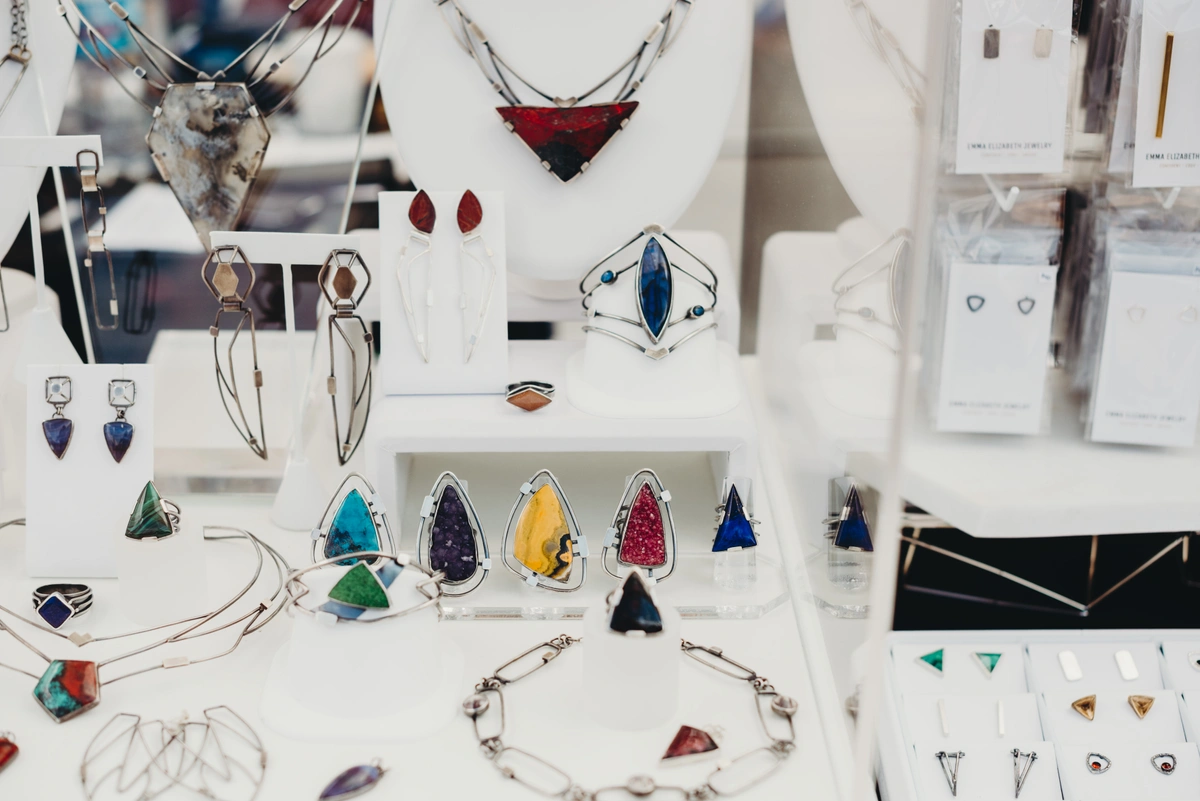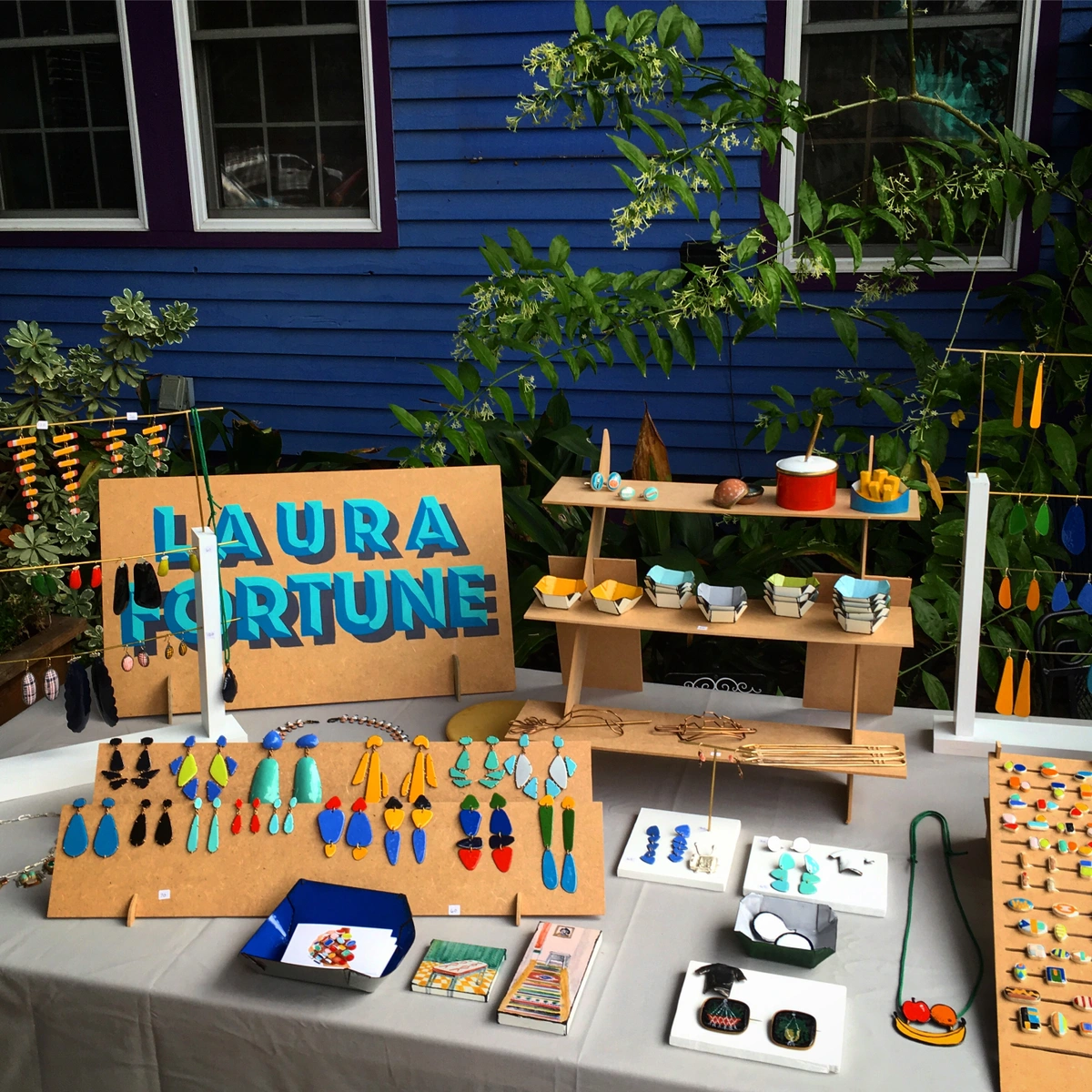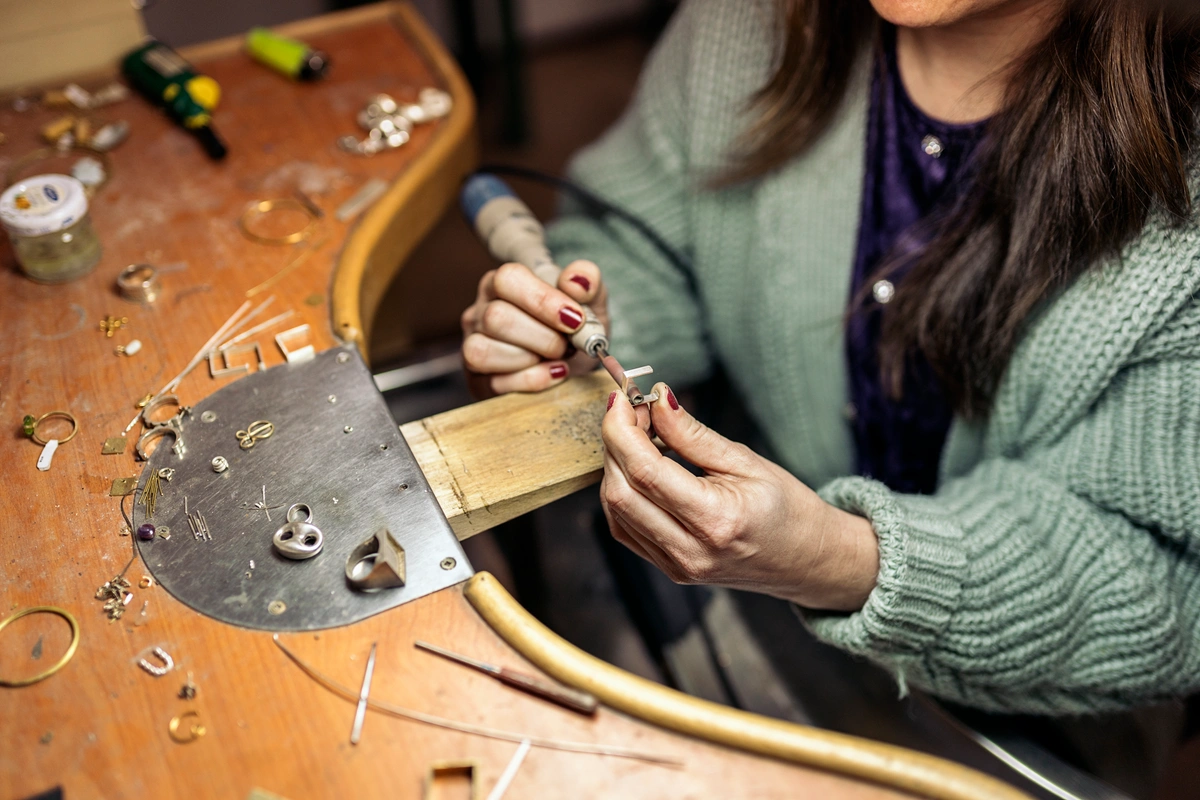Making your jewelry is the fun part of owning your own jewelry business. But the reality of owning a jewelry business is that you have to run the business-side of things. Read on for our top 5 tips on how to run a jewelry business.
Having a successful jewelry business can look different to each person. But for most, the goal is going to be making jewelry you’re proud of and selling it to people who love it – while providing yourself with a comfortable income. In order to do that, not only do you need to know how to make jewelry but you also need to start building a business strategy.
Tips For Starting A Jewelry Business
Create an Identifiable Brand
When someone sees your jewelry (whether in person or online), they should be able to immediately identify it as yours. This is done through branding. Jewelry branding distinguishes your jewelry from every other handmade jewelry business on the market (and there’s a lot out there). Your brand should help you connect with your customers, show them that you share interests. Your branding should come through in a variety of ways.

First, create your brand through your jewelry designs. Your collections should be a reflection of your jewelry brand.. Create cohesive collections that work with your personal values and mission statement.
Next, your branding should come through in your marketing. Start with your most visually obvious piece of marketing – your logo design. Your logo will be all over your website, packaging, and more so you want to make sure it embodies your jewelry brand. Your brand should also show through in the creative jewelry content you share on each of your platforms. Your photos, videos, and writing will be what potential customers see while they’re deciding if they want to buy your jewelry. Let your brand and personality show through!
As part of your branding efforts, let your customers get to know you. Turn your artist bio into a jewelry story. This is your chance to connect with your audience and tell them how you began your jewelry making journey. Let them know how your brand became what it is.
Finally, make your mark on your jewelry. Adding custom jewelry tags will always keep your brand in your customer's minds whenever they wear your jewelry.
Get Your Business Organized
Here are a few things to make sure you have in place before you make your first sale:
Decide on your business entity and register your business with a DBA, LLC or S-Corp. Your business structure or entity structure depends on how much profit your business makes, so make sure you consult with a CPA for the best advice on business structure. Keep in mind this can change over time.
Get a separate Tax ID from your Social Security Number. Once you form your business entity, you can register for a Tax ID that is separate from your Social Security Number. This is a great idea, especially since you can use this Tax ID instead of your Social Security Number when working with vendors, suppliers, and reporting taxes. It's how you officially start your jewelry business!
Apply for a Resale License or Certificate of Authority. If you live in the United States, you must have a license to collect tax in your state. The name of the license will vary state by state. Some suppliers will require a copy of your license to open an account.
Open up a business bank account that's separate from your personal account. Once you have your DBA or other business entity in place, you can open up a separate business bank account. It is very important in the eyes of the government that you separate your business income from your personal income. Use your business bank account to pay for business expenses like supplies, overhead, and any contractors or employees you work with.
Know Your Target Market
If you try selling your jewelry to everyone in the world, you’re going to end up wasting money, time, and energy. It's a simple fact that not every single person is going to like your jewelry. Knowing who your jewelry target audience is will help your marketing efforts be more successful.
Think about your personality, the personality of your brand, and the type of person you’re trying to attract. Are you designing jewelry for a career/corporate minded woman? A world traveler? An outdoors enthusiast? Is your jewelry more likely to be a self-purchase or a gift?

Ideally, you should be able to pinpoint a few things about your customer:
- An age range or a certain life event – I.e. 35-45 years old, motherhood, etc.
- A few interests - I.e. outdoor activities, shopping downtown, traveling, etc.
- Disposable income – fresh out of college and well-established in a career are very different levels of income
- Where they are physically – office setting, staying at home, out with friends; or if you make a line of jewelry specific to a geographic location, you may want to put more work into targeting that area
- Where they are digitally – Instagram, TikTok, Facebook – some of this will be based on your demographic's age, so make sure you understand the demographics of each social media
These are just a few things to think about. Take the time to think through who exactly you most want to target with your marketing.
Know Your Competition
Although your jewelry is unique and often one-of-a-kind, never think that there’s no other jeweler out there who has a similar aesthetic and audience. Everyone has competition. Look around Etsy, Google, and your local area to see who’s out there. For example, if you make mountain-themed jewelry, search for that online and create a list of each maker that focuses on that as well.

Once you know who else is out there, figure out how you differ from them. Do some of them work only in gold while you only work in sterling silver? Or maybe some of them work in base metals. Do they solely focus on the same design aesthetic as you or is it one of many? Is there anything you do better than them? Is there anything you can improve on compared to them? Check out their pricing, their branding, their website, the purchase process (you don’t have to buy an item but go through the steps to see how it works). People will buy the exact same piece of jewelry from a website that looks nicer and is easier to use – even if it’s slightly more expensive.
If you have a local storefront or are putting jewelry in a boutique storefront, scope out the local competitors. Their work may not be the same aesthetic as yours but knowing who you’re competing against for local purchases will help you determine where your jewelry should go to reach the right market.
Develop Strategic Pricing
Ask any experienced jeweler what the easiest part of their business is. There’s a good chance that accurately pricing the pieces will not be the answer. Many makers go with a simple 2-3x cost as the retail price. This isn’t always the best idea. To make your business sustainable and able to provide you with a livable income, you’ll want to think a bit more strategically. A solid pricing strategy will help you make sure all of your business expenses are paid, provide you with an income so you don’t have to worry about a second job, and grow with your business.

There are a lot of little (and not so little) costs to running a jewelry business besides your materials. Some of these are fairly set fees, such as studio rent, software or professional service fees, supplies and equipment, etc. If you have any other employees, their salaries would be in there as well. In a good jewelry pricing strategy, all of these should be considered. Don't be afraid to price your jewelry for what it's really worth. Just be sure you're marketing it to the people who are able to pay your prices.
Hilary wrote a great article on pricing your jewelry – including an interactive pricing guide to help you determine your own prices and a webinar where she walks through the guide.
Make a Business Plan
You often meticulously plan out each piece of jewelry before getting started. Why doesn't your business deserve the same? A successful jewelry business must have a plan. If you don’t have a goal or a plan in place to reach it, how will you know if your business is successful?

If you started making jewelry as a hobby, you may decide to eventually turn it into a business. At first you may just sell a few pieces here and there to friends and family, but if you decide to start selling on Etsy or your own website, you’ll want to think strategically about how to run a jewelry business.
Or maybe you studied metalsmithing and have been working for others while hoping to have your own jewelry business. It's time to start thinking about everything you’ll need to do in order to succeed.
The first thing any successful business needs is a business plan! Check out our jewelry business plan toolkit to guide you through creating one. This will help you determine your business goals, what you need to do to reach those goals, and how to expand on those goals as your business grows. Answer some of the biggest questions for your business with the following resources.

Where will you sell your jewelry?
Of course you'll most likely want to sell your jewelry at fairs and shows so customers can see your pieces up close and in-person. But a digital presence is required to have a successful jewelry business. Many jewelers choose to sell their jewelry on multiple platforms - Etsy, Amazon, website, etc.
How will you market your jewelry?
Marketing your jewelry requires a mix of creativity and strategy. Your marketing materials should look beautiful and make your jewelry shine like a star, but deciding where to market your jewelry and what materials to create should be done based on your audience and where they are.
Do you have quality photos and videos of your jewelry?
Whether you choose to have a professional do your photography or try to do it yourself, good photos are vital to sell your jewelry online. Customers won't be able to see it in person, so you want to make sure they understand exactly how a piece looks. White background photos are best to show off the piece, while model shots can help customers understand the actual size of it. Video has taken off the last few years, so you want to make sure you plan some video content to market your jewelry and brand as well.
How will you fund your jewelry business?
Especially when you're first starting out, your business may need extra funding help. There are a lot of options for grants and loans out there, so do your research and find what fits best for your business.
When your business starts growing, what can you do?
As your business grows, you may find yourself needing additional help or wanting to expand. If you aren't already, you may want to try out custom jewelry or selling wholesale. And chances are you'll start needing help around the studio and/or with business tasks.
Build Sales Confidence
Without sales, you don't have a business. It's essential that you build sales confidence from the "get go" so you aren't afraid to put yourself out there.
Get Into A Sales Mindset
The first way to build sales confidence is to focus on your sales mindset. Meditate, practice sales affirmations, and actually get out there and sell!
It's been said that it takes 6-10 touches before an interested prospect will buy from you. So if you're giving up after 1 or 2 tries, you're almost never going to get a "yes"! Persistence pays off big time when it comes to sales, so don't get discouraged.
Sales Tactics
Sales happen in a variety of ways, often through sales calls, emails, text, messenger and in-person meetings.
Create an outreach plan and stick to it! This builds your resilience muscle by focusing on sales activities every single day.
Take Daily Action to Make Your Sales Goals
If it's not scheduled, it's probably not happening. Everyone is busy so you need to get serious about your sales efforts when you start a jewelry business.
Block out time in your calendar every working day to call customers, outreach to potential clients, and focus on Revenue Generating Activities.
Turning Your Jewelry Making Hobby Into A Business
Making jewelry as a hobby is a great hands-on creative outlet for a lot of people. At some point, many people take it a step further start a small business! But transitioning from hobbyist to jewelry business owner isn't always easy.
Make a Plan
First, think about where you are now and what your ultimate goal is for your jewelry business. Are you fresh out of school and hoping to make it your permanent profession? Michael David Sturlin says, "I started at the age of 17 with the intent to make goldsmithing my profession. That was 49 years ago. I have worked and supported myself at the bench ever since." Are you looking for a career change after finding your current profession unfulfilling? Or are you like Fiona Webster who hopes "to build a semi-retired lifestyle and focus on my creative streak doing something I love."
Understanding where you currently are and having a goal in mind will help you develop the right business mindset. Someone looking to professionally make jewelry as a primary career for 40 years may have different business planning tactics than someone looking to switch careers or have a later career. If you plan to make your jewelry business your sole income at some point, know this and treat it as such from the beginning.
You may want to consider finding a mentor as you start on your jewelry business adventure. This may be a teacher/instructor from one of your jewelry classes or a formal mentor from an organization you sign up for. If you decide to work for another jeweler while you’re starting your business, this jeweler is a great mentoring resource. Your mentor can help you with jewelry-related questions, business-related questions, and help you network and expand your circle of jeweler friends.
Get Started
Has your hobby or side-hustle grown to something bigger? Do you find yourself wondering what comes next?
Working part-time for your jewelry business comes with the requirement of knowing how to manage your time well and learning to maximize your available time. When will you work on your business? You may have to find time after your regular job and on days off. Getting your first sale (outside of friends and family) might be the hardest part of starting your own business, but it will make your time and energy worth it.
I did a lot of all kinds of art as a kid through high school. Then I and got a BFA in printmaking and later worked as a technician in sculpture foundries and as a graphic artist before going back to college to get a teaching certificate so I could teach art. One of the required classes was jewelry-making. Everything in my background came together in that and I decided that was what I really wanted to do. 33 years later I'm still at it. - Suzanne Williams
Move Toward a Full Jewelry Business
As you start your jewelry-making business, you'll probably be focusing on learning various jewelry-making techniques. But to create a successful jewelry business, you'll need to shift your focus to the business tasks as well. The best way to start this shift is to work on a business plan. Creating a business plan will not only help you focus on what you need to accomplish, but will also be vital if you ever need to apply for jewelry business financing.
This is a great time to start learning about jewelry business finances. There are a lot of software options to help you keep your business finances on track. You may want to consider taking classes from an organization like the Small Business Administration to learn how to track your business finances.
You'll also want to work on creating a jewelry collection and make sure you understand the current trends. Starting out with your hobby, your jewelry designs may be all over the place as you practice various techniques. As you progress towards a business though, your jewelry should start to form collections that work together.
Start Developing Your Marketing
Having beautiful jewelry is great. But if no one sees it, how will it sell? Investing your time and money into a good jewelry marketing strategy will make all the difference to get your business off the ground.
Having an online presence is vital when you're selling your jewelry. Whether you're selling on social media, a marketplace website, or a website, it's important to get your jewelry out there in the digital world. Selling in person at fairs and art shows is also a great option, but it's best not to rely solely on this tactic. Deciding where to sell is important as it will affect your marketing strategy down the road. Think about your target customer and where they shop. Selling to a 35-year-old stay-at-home mom isn't the same as selling to a 35-year-old career woman. Take some time to learn about your customers so you'll know who to target for future marketing campaigns.
What is your branding going to look like? It's time to think about your logo, your packaging, your voice and aesthetic, etc. Think about the image you want to portray as a business and how your voice should be represented on your social channels, website, and email correspondence. This also extends to your elevator pitch! How will you convince someone to buy your jewelry in a short amount of time - a couple of minutes at most?
"I have focused on learning the technical skills of gold smithing, but it is an expensive hobby and as the pile of jewellery started to grow and the wants (micromotor, rolling mill, 35 different hand tools, burrs and everything in between), it seemed logical to start selling - particularly when I got to the stage that my husband said he would be prepared to buy my jewellery. - Fiona Webster
Is it Time to Quit Your Day Job?
How do you know when you're ready to take your jewelry-making hobby to a full-time business? Think about these questions:
- Do you have the tools and the dedicated space for a full jewelry-making operation?
- Is your part-time business bringing in a good amount of money?
- Are you investing more and more of that money back into your business?
- Do you have a clear pricing strategy?
Knowing if your jewelry business is ready to take full time is a personal decision that only you will be able to make. You should feel comfortable enough with your financial situation that you no longer feel the need for your second job. Take some time to figure out your plans for growth. Will you need to hire an employee? Will you need to outsource some of your pieces, i.e. some of your casting? You may also want to consider outsourcing some of your business tasks to independent contractors at some point as well.
Perks of Owning a New Business
Congratulations, you are on the road to financial independence! Beyond an increase in sales, there are other perks to being an official small business owner.
- You now qualify for wholesale jewelry pricing
- You can open a business bank account
- You can accept credit card payments
- Enhanced trust with your customers
- Tax benefits of expensed business costs
Free Resources To Start Your Jewelry Business
Starting a small business may seem like a daunting task, but don’t get discouraged, there are resources that can help.
If you think you need additional advice after consulting with one or more of these, a CPA (certified public accountant) or a tax attorney can fill in the blanks, often for a fee.
Jewelry Making Side Hustles
Sometimes as a jewelry business owner you feel the need to take up a side gig - maybe it's a financial need or a desire for extra jewelry-related experience to build your resume. Sarah Rachel Brown has some great ideas for side hustles for jewelers!
Teaching
There are many ways to approach this option. Do not get narrow-minded in how you can make cash off of sharing your knowledge, think outside traditional educational formats!
Host a small workshop in your studio. If you've got the space, use it! Sarah suggests starting small by hosting something like a stacking ring class where a group of friends can come and make simple rings out of wire. Charge an amount that you would pay for a night out with your friends and have the experience include snacks, drinks, and a completed project. Keep it short, small and manageable. 5 participants paying $75 each means you make $375. Your profit margin will be small the first time around because you're putting in a good amount of prep work, but hosting a weekly workshop could mean an extra $1-2K per month in your pocket once you get everything streamlined.
Check with local fine arts centers and submit a proposal for a week-long or weekend workshop. Short-format workshops are a great way to build up your teaching experience and won't keep you from your own studio for too long. Don't wait to be asked, reach out and let them know you're interested.
If you have your MFA, many colleges and universities need adjunct professors. If you're a small business owner who can dedicate one or two nights a week to teaching, this is a viable option.
A great way to create passive income is through online tutorials. Put in the time to create well-produced, informative videos that you can market and make available for download for a one-time fee. If 10 people a week download your video for $20 per download, that's $800 a month in passive income.
Social Media
This is a great option for those who do not have solid chunks of the workweek to dedicate outside of their studio but perhaps have some time to spare in the mornings or evenings.
Not sure where to find this type of work? Start by posting on your own platforms that you're offering part-time social media management. This can be as simple as offering to post to someone's account 2-3 times per week. Do not charge by post, rather give them your monthly rate and what your deliverables are. Make sure you have an agreement in place to ensure you and the client are clear on how much time you are able to dedicate to their needs.
You can't post without content and this is one area that creatives are consistently wanting help with. Offer your content-creation services via one-day or hourly rates which gets the client your undivided attention in their studio to take photos, capture video, and brainstorm copy for their platforms. Make sure you factor in your time for editing! Again, have an agreement clearly noting what the deliverables are and the timeframe for receiving them.
Administrative
Many administrative tasks are online-only and so it can be relatively easy to find part-time work that allows you to work from home on a flexible schedule. Reach out to organizations or businesses that you're already connected to letting them know you're available for hire. Perusing job banks for gigs that might not be directly related to jewelry, but help you improve your skills is worth exploring.
Bookkeeping can include a variety of tasks so make sure you're fully aware of what is expected and that you have the know-how to make it happen. If you don't have the skills, get your certificate through an online training program. For a small business owner, this is a win-win situation.
Maintenance of computer data might sound monotonous, but sometimes it's nice to have a task that doesn't take too much of your mental energy. If the pay is decent and you can work from your studio, why not?
Overall, administrative tasks require proficiency with programs such as Excel or Quickbooks. Sarah's advice is to seek these skills then find a side hustle that allows you to utilize them and enhance your knowledge of the programs. Your small jewelry business will thank you.
Contracting For Other Jewelers
If you crave more time at your bench, capitalize on that need! Again, reach out to your creative community and let them know that you'd be happy to help out a fellow studio jeweler for some extra cash.
Working per piece vs. per hour. This means that you're paid an amount per piece that you clean, cut, polish, etc. The key to this approach is your efficiency and so it might be a scenario wherein the beginning you're not making much but over time, your income will grow. This is an excellent way to build up that one skill we as studio jewelers all need - efficiency!
Sometimes it's nice to get out of your own studio and be around other jewelers who share your similar goals or passions. If you can find a bench jeweler gig that allows you to work 1-2 days a week in a healthy studio environment, go for it. The right opportunity could lead to a wonderful mentorship in your life.
This blog includes contributions from Sarah Rachel Brown and Tracy Matthews.












